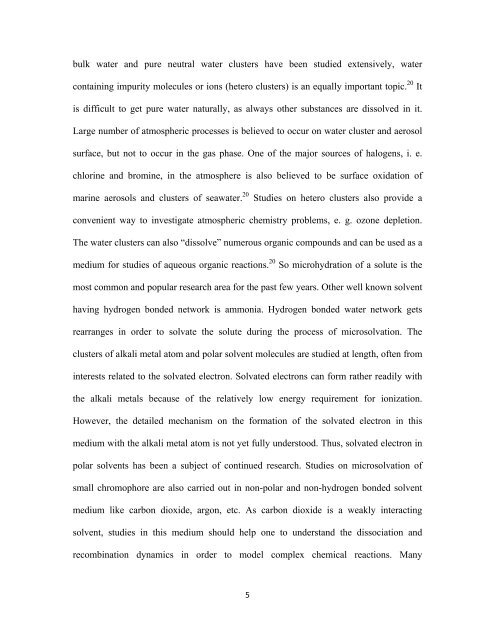CHEM01200604005 A. K. Pathak - Homi Bhabha National Institute
CHEM01200604005 A. K. Pathak - Homi Bhabha National Institute
CHEM01200604005 A. K. Pathak - Homi Bhabha National Institute
Create successful ePaper yourself
Turn your PDF publications into a flip-book with our unique Google optimized e-Paper software.
ulk water and pure neutral water clusters have been studied extensively, water<br />
containing impurity molecules or ions (hetero clusters) is an equally important topic. 20 It<br />
is difficult to get pure water naturally, as always other substances are dissolved in it.<br />
Large number of atmospheric processes is believed to occur on water cluster and aerosol<br />
surface, but not to occur in the gas phase. One of the major sources of halogens, i. e.<br />
chlorine and bromine, in the atmosphere is also believed to be surface oxidation of<br />
marine aerosols and clusters of seawater. 20 Studies on hetero clusters also provide a<br />
convenient way to investigate atmospheric chemistry problems, e. g. ozone depletion.<br />
The water clusters can also “dissolve” numerous organic compounds and can be used as a<br />
medium for studies of aqueous organic reactions. 20 So microhydration of a solute is the<br />
most common and popular research area for the past few years. Other well known solvent<br />
having hydrogen bonded network is ammonia. Hydrogen bonded water network gets<br />
rearranges in order to solvate the solute during the process of microsolvation. The<br />
clusters of alkali metal atom and polar solvent molecules are studied at length, often from<br />
interests related to the solvated electron. Solvated electrons can form rather readily with<br />
the alkali metals because of the relatively low energy requirement for ionization.<br />
However, the detailed mechanism on the formation of the solvated electron in this<br />
medium with the alkali metal atom is not yet fully understood. Thus, solvated electron in<br />
polar solvents has been a subject of continued research. Studies on microsolvation of<br />
small chromophore are also carried out in non-polar and non-hydrogen bonded solvent<br />
medium like carbon dioxide, argon, etc. As carbon dioxide is a weakly interacting<br />
solvent, studies in this medium should help one to understand the dissociation and<br />
recombination dynamics in order to model complex chemical reactions. Many<br />
5
















